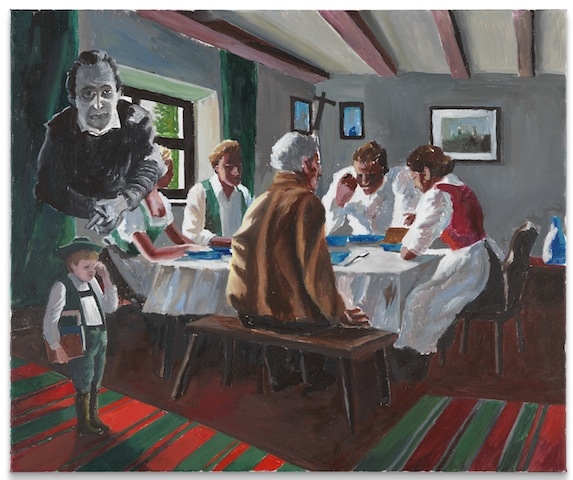Galerie Barbara Weiss, Berlin 15 September – 29 October
In her first solo show at Galerie Barbara Weiss, Amelie von Wulffen startles viewers with genre paintings that seem oddly antiquated: they predominantly depict people sitting at tables in rural settings. The first image in the exhibition shows four elderly people seemingly in mid-discussion and before a light-green background. The image, based on a historical photograph, presents two figures we may recognise: the German philosopher Martin Heidegger, who had dubious ties to National Socialism, and the Jewish religious scholar Martin Buber. Also depicted is the artist’s grandfather, who arranged this gathering in 1957 to allow the two thinkers to discuss their attitudes towards National Socialism. The paintings in the exhibition do not primarily constitute a biographical self-inquiry, but rather an exploration of the question of guilt, and the ongoing tradition of rightwing thought, in Germany and beyond.
Von Wulffen shows that genre painting reflects not only an ‘ideal world’ utterly devoid of social and political problems, but also that these fraudulent idylls expose the exploited nationalist longings for unspoiled nature, a pure völkisch homeland and harmonic family life
Another painting – all works are untitled and dated 2016 – shows a family of five eating a meal together in the parlour, a scene recalling a more-or-less kitschy nineteenth-century painting. A cross hangs in a corner of the room; the people are clothed colourfully in traditional dress; paintings hang from the walls. In the foreground the artist has painted a cute little boy, crying, with schoolbooks under his arm. However, hovering somewhat spookily over the room, and painted in black and white and with greater realism than the other figures, is a portrait of Paul Celan, whose well-known poem from 1944–45, ‘Todesfuge’ (‘Death Fugue’), attempted to capture in words the horror of the Nazis’ persecution of the Jews. This collage of various styles and eras is typical of most of the exhibition’s paintings, which consciously invoke works by historical genre painters such as Franz Defregger or Gustave Caillebotte. Other paintings reference right- wing philosophy less directly, but throughout this exhibition there lingers an atmosphere of demonic destruction: above all, perhaps, in images of burning cities, which recall, not without intent, the bombing of Dresden in February 1945, or in von Wulffen’s grotesque scenes depicting absurd fantasies of angst-inspiring monsters, burning children and mysterious cats.
In naming the exhibition The Dead in the Swamp, the artist is playing off the titles of cheap crime novels and popular TV crime series. Concerning the latter, von Wulffen once said in an interview that in postwar Germany these served as a ‘catalyst for the horrifying, guilt-ridden images of human torment and mass murder in the concentration camps’. Her paintings also reflect the amalgamation of guilt, rightwing ideology and the media, and it is this quality, combined with her very own medium, namely painting and its potential to free the imagination, that makes this exhibition so convincing. Von Wulffen shows, for instance, that genre painting reflects not only an ‘ideal world’ utterly devoid of social and political problems, but also that these fraudulent idylls expose the exploited nationalist longings for unspoiled nature, a pure völkisch homeland and harmonic family life. The fact that this emotional trinity still prevails today in wide swathes of Western society, as current rightwing populism has unfortunately laid bare, makes artistic and historical deconstructions like von Wulffen’s all the more urgent. In this context, therefore, a painting that on first glance may seem harmless, such as an almost romantic depiction of three children playing music for an old woman in a rural, interior setting, becomes imbued with exceedingly critical ideology. On second glance, the viewer perceives that the children are painted wearing modern everyday clothes, while the old woman is in antiquated traditional dress…
Published in the January & February 2017 issue of ArtReview
